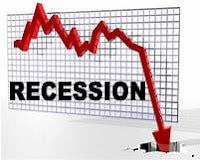Don't Ignore Recession Warning Signs

Every week we hear more about how the economy might be slowing, companies are reporting lower earnings than last year, trouble brewing in Europe with a slowing economy and yet the stock market keeps going up, most recently the bond market has dropped as long rates have risen and most investors continue to be bullish and pile into stocks. As an investor it's important not to ignore the warning signs and make sure you have Built a Financial Fortress for yourself and your family.
It's not whether we will have a recession, it's simply a matter of when. Every recession is a little different. The Great Recession was triggered by a collapse in residential real estate values and lending, ultimately bringing down with it some of the largest financial institutions of the time and many banks. This time it may be different. I have assembled a few charts to help tell the story of what is happening now and what might trigger the next recession.
US stock market (S&P 500) continues to move up due to low interest rates, favorable trade news, generally good economic news (mostly about the US consumer), with no sign of weakness in the near term; a collapse in stock market values from their current highs (30% or more correction, which is certainly possible especially as the market continues its move up) will impact consumer sentiment and ability / desire to spend money, which is a key driver of economic growth:

Money supply has resumed a strong upward growth trajectory, keeping cost of borrowing low and ensuring a steady flow of credit, which is very important to the consumer and the Fed has an unlimited capacity to print money. The downside is that it makes the dollar weaker in the long run, which makes everyone poorer who holds cash.

Interest rates are already getting close to zero so there is not much more room to continue to lower rates. The Federal Reserve has stated that they don't plan to allow interest rates to go negative as they are in many other countries - a situation that is unprecedented and no no one really knows what the long term effects of this will be. With rates already so low and with a recession looming, it's certainly possible to see negative rates in the US regardless of what the Fed has previously stated:

Meanwhile, real GDP growth has actually been negative for years (that's why for many it feels like the Great Recession never ended); even the official number has been dropping recently:

The real story behind the recovery since the Great Recession is the growth of consumer debt, which currently stands at just over $4 trillion and has almost doubled since the end of the last recession; the collapse of consumer credit could trigger the next recession, since the consumer drives about 70% of the economy:

Indeed the growth of "shadow banking" $45 trillion or about 7.6% of all financial assets in 2016 when last measured, is also a significant risk since these are beyond the reach of regulators (think Bear Stearns and Lehman Brothers), with the US leading the rest of the world in having the largest share of risky shadow banking assets - see chart below. Today shadow banking comprises pawn shops, peer to peer lending (i.e., Prosper), private equity lending and businesses that provide credit to customers for buying their products in addition to broker dealers and money market funds.

If you're interested, I recently put together a recession preparation checklist post here. Hopefully we'll have another year or so of calm before the storm, but it pays to always be prepared.
I hope you find this post useful as you chart your investing course and Build a Financial Fortress this year.
To see all my books on investing and leadership, click here.
Disclaimer: I use affiliate links where I get paid a small amount if you buy the service or product. This helps support my blog.



